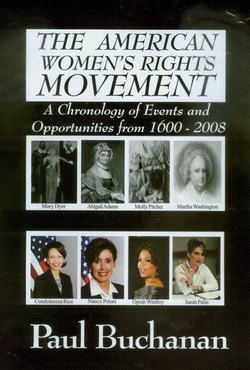Читать книгу American Women's Rights Movement: - Paul D. Buchanan - Страница 3
На сайте Литреса книга снята с продажи.
ОглавлениеPREFACE
The entries chronicled in this work depict events which have had lasting national significance in opening opportunities in the struggle for equal civil rights and opportunities for women. The impact of many of the included events was initially felt on a local level; but in time it created repercussions that spread across the country. These stories feature women – and men supporting the struggle of women – who were trailblazers, whose actions paved the way for those who followed them. These women were heroes – whether subtle or obvious – who for the most part have not received the comparable attention enjoyed by their male counterparts through history. However, their importance and impact on their gender – and the country – is at least as impressive as the men.
The common historical assumption was that – particularly in the 17th through 19th centuries – the man assumed the role of provider and head of the house, while the woman was the homemaker and child care provider, subject to the rule of the male. However, as these stories illustrate, there were a great many exceptions to the common myth; in fact, the exceptions were more common than history could have ever recorded. They would show women assuming the role of provider and head of the household, due to a number of circumstances involving the male: sickness, disability, absenteeism, death. The leadership these women exerted in and outside the home would often manifest in the community at large and, in turn, in the nation and in the world.
The reader might wonder why I, as a man, would be drawn to the subject of women’s rights and opportunities. First of all, there is a fascination with historic accounts that have not generally made it to the mainstream history books. In addition, the issue of equal opportunities and rights for women is essential for my own personal development and fulfillment. If women are pigeon-holed to particular roles, opportunities, and ideas, men also will be bound to similar confinements. The more expansive the opportunities for women to engage in whatever activities and vocations they wish, a similar bountiful selection of prospects will arise for men. The more women are allowed to develop as human beings to their full potentials, so the same may be said for men. If each gender is allowed to share equally the burdens and benefits of life, each person will enjoy the prospect to be more wholly realized.
My wife is of the opinion that women, in general, are more in need of – and better at developing – “connections” than men are. That is, there seems to be an innate drive – perhaps due to the maternal extinct, perhaps due to the roles society have traditionally established for women – to create relationship and community. Particular in this age of global interaction and conflict, in which the interdependence of each nation upon the rest is beginning to be fully realized, it may be of utmost importance that women now take a greater leadership in creating a world community which values peace, stewardship, and consensus. It seems most appropriate, then, to echo the words of Jeannette Rankin – the first woman member of Congress – uttered more than ninety years ago: “Peace is a Woman’s Job”.
PART ONE
